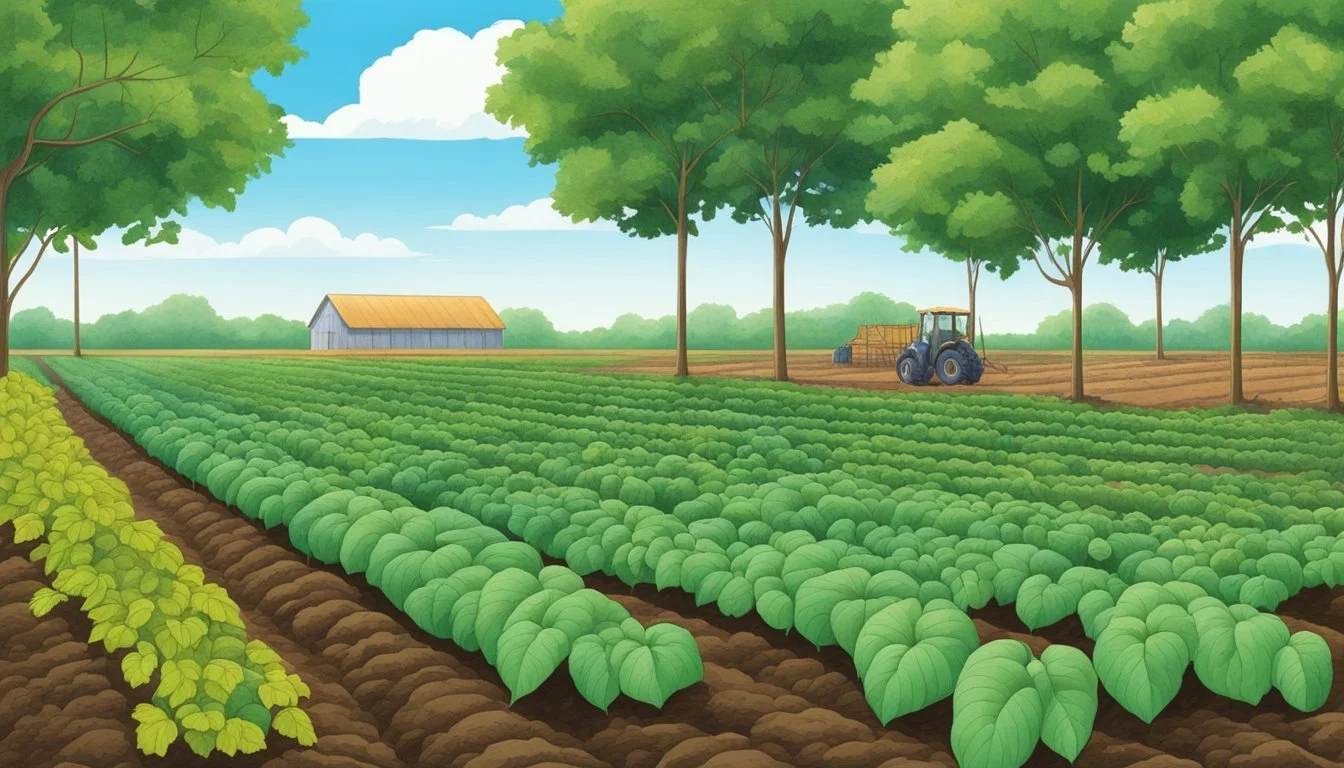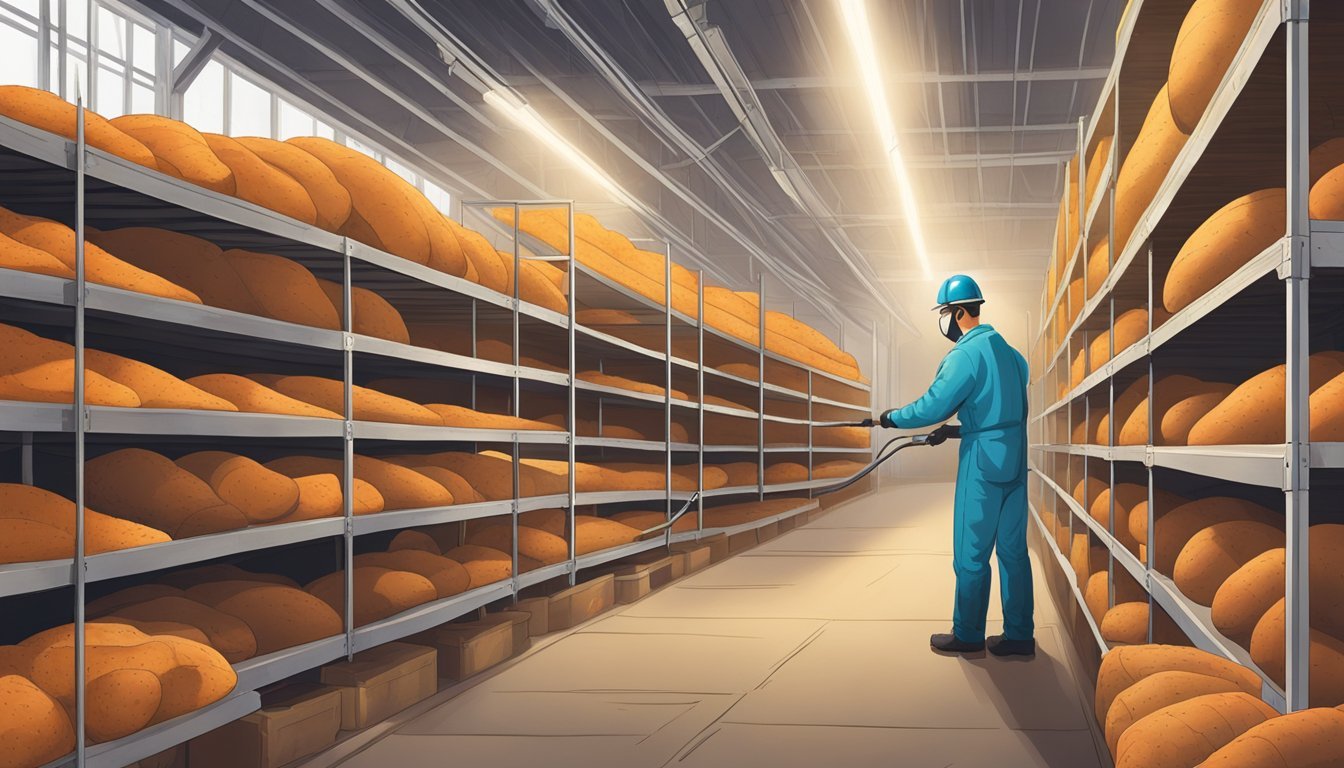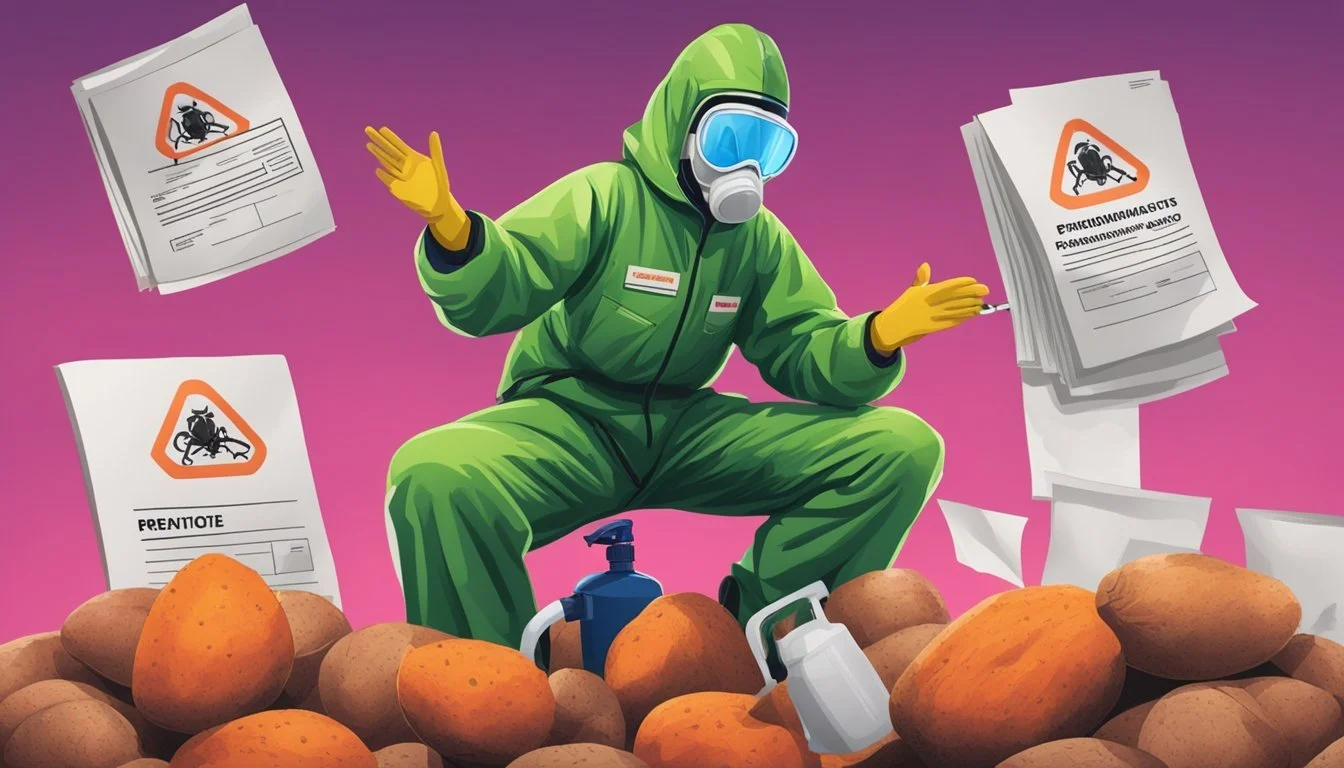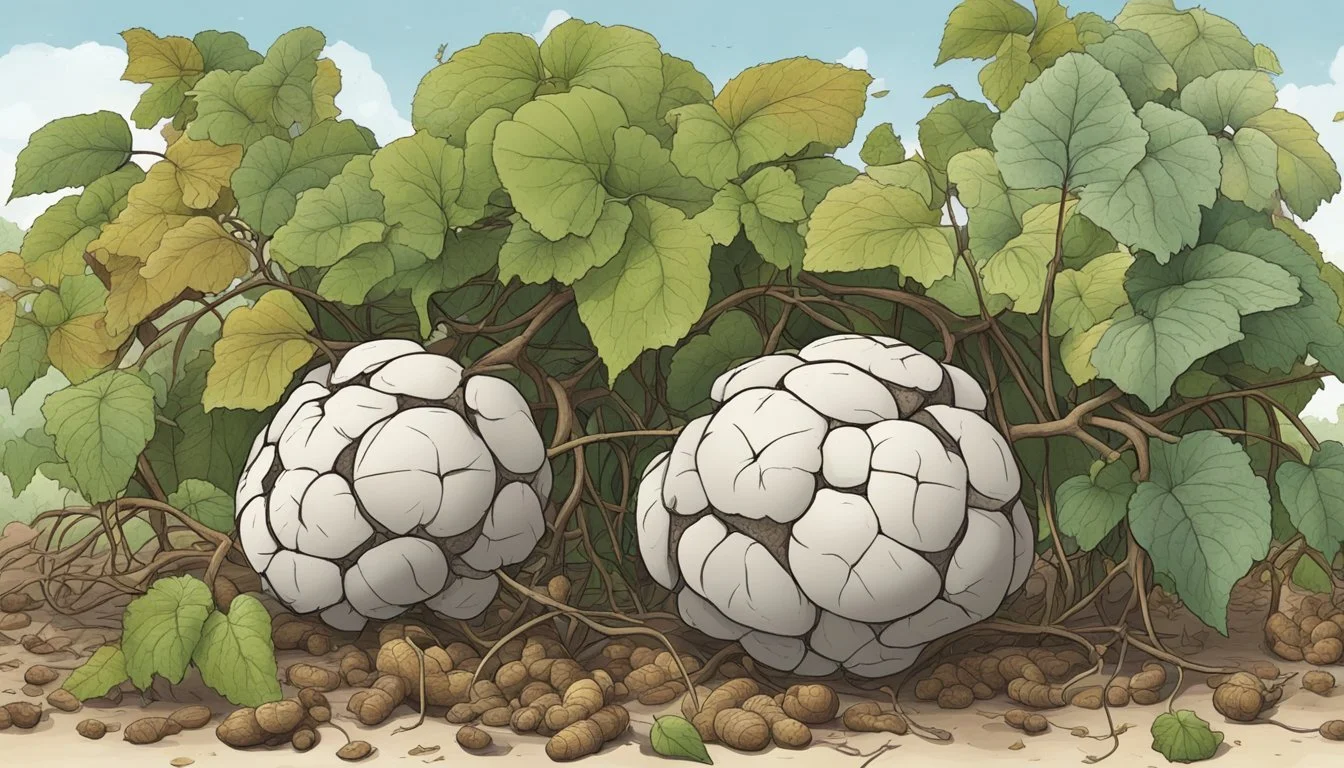Pest Control for Yams
Effective Strategies for Healthy Crops
In the cultivation of yams, a staple food crop derived from the tubers of Dioscorea species, controlling pests is a critical aspect of ensuring healthy growth and optimal yield. Yams are particularly prone to a variety of insect pests that can significantly reduce crop quality and quantity. These pests range from soil-dwelling insects like the sweet potato weevil to foliage attackers such as the yam beetle. Each of these pests presents unique challenges that require strategic management techniques to control effectively.
Effective pest management in yam production encompasses a combination of cultural, biological, and chemical strategies. Cultural practices, such as proper land preparation and planting methods, can help mitigate pest infestations. For instance, the ridging of soil and appropriate spacing between plants are known to enhance the accessibility for pest control measures and improve plant health. Biological methods, including the use of natural predators and pheromone traps, can be integrated to suppress pest populations without resorting to chemical pesticides.
When chemical interventions are necessary, it is essential to apply them judiciously to minimize any adverse environmental impacts while maximizing their efficacy against yam pests. Careful monitoring of the yam plantation for early signs of pest infestation and proper identification of pests are paramount for the successful implementation of integrated pest management strategies. Addressing pest control for yams not only preserves the crops but also safeguards the livelihoods of farmers who depend on this valuable food source.
Yam Plant Overview
Yams, a group of tuberous crops, hold significant agricultural and sociocultural importance in areas like West Africa and are notable for both food security and their role in various economies.
Species and Varieties
The genus Dioscorea encompasses a variety of yam species, crucial among them being Dioscorea alata, also known as the water yam, and Dioscorea cayenensis, commonly referred to as the yellow yam. There is also the lesser-known Chinese yam (Dioscorea polystachya), which is distinguishable from its more common counterparts. Each species is adapted to different ecological zones, with Dioscorea alata being widespread in regions like the Caribbean and Asia.
Anatomy of Yams
Yams are primarily known for their tubers, which serve as the plant's storage organ. The tubers vary in size and shape based on the species and can be quite large. Above ground, yam plants have climbing vines with broad leaves that can vary in shape from heart to arrowhead forms.
Cultivation Practices
Successful yam cultivation requires well-draining soil with a slightly acidic to neutral pH. The planting process often involves constructing mounds or ridges, aiding drainage and reducing tuber rot. Yams are vegetatively propagated, typically using small tuber sections or vine cuttings.
Harvesting and Storage
Yam tubers mature over several months and are generally harvested manually. Careful handling is necessary to avoid damage that could affect the yield and the tubers' storage life. Once harvested, yams should be stored in cool, dry storage areas to minimize decay.
Importance of Yam
In countries like Ghana, Nigeria, and other parts of Africa south of Sahara, yams are a vital crop for both nutrition and economics. They are a source of complex carbohydrates, dietary fiber, and micronutrients, contributing to the nutritional requirements of the population.
Yams in Food Security
Yams play a crucial role in food security, especially in regions where they are a staple food. Increased yield and sustainable farming techniques are at the heart of sustainability efforts for crops like yams, ensuring that there's enough produce to meet the demands of growing populations.
Pest Management in Yams
Effective pest management in yam cultivation is critical to sustain healthy crops and yield. This section digs into various strategies and insights for controlling pests and diseases affecting yams.
Understanding Pest and Disease Life Cycles
Grasping the life cycles of pests and diseases is fundamental for timely and efficient management. Insects such as mealybugs, aphids, and whiteflies could inflict damage during specific phases of their development. Yam mosaic disease and anthracnose are caused by pathogens that also have unique life cycles influencing their spread and impact on yams (Dioscorea spp.).
Common Pests in Yam Cultivation
Yam fields are commonly affected by a range of pest insects including Aspidiella hartii, aphids, whitefly, thrips, and nematodes. The presence of these pest arthropods can lead to reduced tuber quality and quantity, potentially harming this vital food and medicinal plant.
Disease Identification
Detecting diseases in yams involves monitoring for specific symptoms like discoloration, lesions, or stunted growth. Yam mosaic disease typically manifests as a mottling or distortion of the leaves, while anthracnose causes sunken lesions on yam leaves and tubers.
Biological and Cultural Control
Biological and cultural methods, such as crop rotation and weed control, help suppress pests and diseases naturally. Leveraging natural enemies of pests and maintaining plant health are also integral to these environmentally friendly approaches.
Chemical Treatment
When necessary, targeted use of pesticides, including insecticides and fungicides, can manage outbreaks. Application must be judicious to minimize impact on beneficial organisms and prevent resistance build-up in pest populations.
Integrated Pest Management (IPM)
Integrated Pest Management (IPM) combines monitoring, pest management decision guides, and a mix of control methods. This strategy aims to reduce reliance on chemicals while enhancing the use of biological and cultural control measures in managing pest insect populations and diseases in yam cultivation.
Environmental and Climatic Factors
Environmental and climatic parameters play a crucial role in the cultivation and protection of yam crops. Ensuring optimal conditions for soil and climate can mitigate pest pressures and enhance yam vigor and harvest yields.
Soil Health and Fertility
Yams require well-drained, fertile soils with a pH ranging between 5.5 and 6.5, ideal for their growth and development. Soil fertility is a critical factor, as nutrient-rich soil supports healthy yam plants that are better equipped to resist pests and diseases. Incorporation of organic matter and proper water management helps maintain soil health, crucial for a successful yam field.
Climate Impact on Pests
The presence and proliferation of insect pests in yam crops are significantly influenced by temperature and other climatic conditions. Yams thrive in tropical and subtropical climates, with optimal growth temperatures between 25 and 30°C (77-86°F). Deviations from these temperature norms can either slow down the growth of yams or accelerate pest activity. Research has shown that climate change can impact the distribution and severity of pests, affecting the agro-climatic factors essential for yam cultivation.
Advance Techniques and Innovation
Advancements in yam pest control have led to more effective and sustainable methods. These innovative techniques vary from genetic solutions to the integration of information technology.
Genetic Resistance and Breeding
Researchers have identified Dioscorea alata and Dioscorea cayenensis as species with potential genetic resistance to various pests. Strategic breeding programs aim to enhance this natural resilience, leading to cultivars that require fewer interventions during propagation and harvest. Genetic analysis steers these efforts to ensure the sustainability of yam crops.
Pest Monitoring and Advisory Services
Monitoring plays a critical role in pest management, with advisory services providing timely information to farmers. These services employ both traditional extension activities and contemporary analysis to forecast pest outbreaks. They enable farmers to implement targeted treatments, reducing the need for broad-spectrum pesticides.
Sustainable Practices and Crop Management
Sustainable practices, such as crop rotation and the introduction of beneficial organisms, have shown to effectively manage pest populations. By disrupting pest life cycles and enhancing soil health, these methods promote a balanced ecosystem within yam cultivation areas. Farmers are encouraged to combine these tactics with regular crop health checks to maintain minimal pest presence.
Use of Information Technology in Pest Control
Information technology has transformed yam pest control through data collection and real-time analysis. Electronic trapping devices, satellite imagery, and mobile apps assist in ongoing pest monitoring. These tools support swift decision-making and can broadcast expert extension advisory services directly to yam cultivators, facilitating timely and effective pest management interventions.
Post-Harvest Handling and Storage
Effective post-harvest handling and storage strategies are crucial in maintaining the quality of yam tubers. They help in minimizing the impact of pests and diseases, while also reducing physical damage to the produce.
Reducing Post-Harvest Losses
Mitigating post-harvest losses involves a series of well-planned actions. Appropriate storage conditions are essential to safeguard yam tubers from the onset of pests and diseases. Traditional storage practices typically involve keeping yams in relatively dry and ventilated environments to extend their shelf life.
Pests, such as beetles and weevils, can cause significant damage to yams during storage. Integrating measures like regular inspection and sanitation of storage areas helps in early detection and potential eradication of infestations. For more detailed information on pest management, the Insect pests and their management in yam production and storage review provides extensive insights.
Diseases are also a considerable threat to stored yams, so maintaining optimal storage conditions to prevent fungal and bacterial growth is imperative. It is important to ensure that yams are cured properly before storage, as this process heals minor cuts and reduces susceptibility to infections.
Finally, to prevent physical damage, yams should be handled carefully during and after harvest. Using padded equipment when moving yams can reduce bruising, which otherwise could be an entry point for pests and diseases.
Yam Pests and Diseases in Specific Regions
Yam cultivation is affected by a variety of pests and diseases that vary by region, impacting the yield and quality of crops. These challenges are further complicated by local agricultural practices and environmental conditions.
Disease and Pest Incidence in West Africa
West Africa, particularly Nigeria and Ghana, is a major producer of yams, supplying a significant portion of the world's yams. However, crops in these areas face threats from several pests and diseases.
Pests: Among the most damaging pests are nematodes, such as the yam nematode (Scutellonema bradys), and beetles like the yam beetle (Heteroligus meles).
Diseases: Fungal diseases, including yam anthracnose (Colletotrichum gloeosporioides) and tuber rot, are prevalent issues that farmers must contend with.
Effective management strategies are critical for maintaining healthy yam crops in this region. Regional research, such as insights from Insect pests and their management in yam, provide valuable information on combating these challenges.
Challenges in Indian Yam Cultivation
In India, specifically in areas such as Thiruvananthapuram in Kerala, yam cultivation faces a distinct set of challenges.
Pests: Scales and mealybugs can cause damage to yam plants, reducing their vigor and yield.
Diseases: Farmers must also manage diseases like yam mosaic virus, which leads to reduced crop quality and plant stunting.
Documentation of the local agricultural practices and pest management strategies, like those found in Yams: botany, production and uses, are essential for improving yam health and productivity in this region.
Yam Health in Subsaharan Africa
The broad region of Subsaharan Africa, known as Africa south of Sahara, encompasses a diverse ecology that supports yam cultivation, yet it also harbors a plethora of pests and diseases.
Pests: Pests such as the African yam beetle and various species of weevils present continuous threats to yams, necessitating active pest management.
Diseases: Diseases like yam mosaic virus and yam mild mosaic virus add to the growers' plight, often causing significant crop losses.
It is imperative to implement region-specific solutions to address these problems, guided by in-depth studies such as those reviewed in Insect pests and their management in yam production, which analyze the taxonomic diversity of insect pests in yams.
Implementing Regulatory and Quarantine Measures
Regulatory and quarantine measures are vital for managing pests and diseases in yams. They protect domestic crops by preventing the introduction and spread of invasive species and pathogens.
National and International Guidelines
National Guidelines: At the national level, countries implement regulatory measures to establish a systematic approach to pest management and disease control for yams. This includes:
Inspection: All yam shipments are subject to meticulous inspections at points of entry, such as airports, to ensure they are free from pests.
Certification: Yams must often be accompanied by a phytosanitary certificate confirming they meet the airport quarantine requirements.
Response: Regulatory bodies outline clear procedures for prompt action if pests or diseases are detected, including eradication and containment strategies.
International Guidelines: Internationally, organizations such as the International Plant Protection Convention (IPPC) provide frameworks for plant health, including the management of yam pests. Countries collaborate under these guidelines to:
Ensure the harmonization of phytosanitary measures among trading partners.
Facilitate safe international trade of yams and other agricultural products.
Pest Risk Management: Implement integrated measures that combine different management strategies for effective control.
The Indian Council of Agricultural Research (ICAR) plays a role in developing pest-resistant varieties of yams and providing guidance on best practices in agronomic management, further supporting these national and international efforts.
Research and Case Studies
In the realm of yam cultivation, research and case studies illuminate the complexity of pest management and its categorical impact on yields. The efficacy of various pest control methods is of particular interest to both researchers and farmers aiming for optimal production.
Impact of Disease on Yield
Research has consistently shown that diseases such as anthracnose and yam mosaic potyvirus have a significant adverse effect on yam yields. A case study focusing on the impact of Scutellonema bradys and Meloidogyne incognita, nematode species, revealed that these pests can drastically diminish crop yields. Integrated disease management approaches are critical for sustaining yam production.
Effectiveness of Pest Control Methods
The analysis of pest control methods in yam cultivation shows a spectrum of effectiveness from direct control measures to biological alternatives. Chemical treatments, though effective, raise concerns regarding food safety and environmental health. Conversely, biological and cultural controls offer sustainable options, though their implementation may be more complex. Studies have demonstrated that a combination of direct, cultural, and biological control methods can significantly enhance disease control while maintaining yam crop integrity.
Educating Farmers and Growers
Effective pest management in yam cultivation requires an understanding of the best practices and strategies. This section focuses on educational efforts to enhance farmers' and growers' abilities to manage pests proficiently.
Training and Extension Programs
Extension services play a vital role in educating yam farmers about pest control. Training and extension programs offer practical guidance, including pest management decision guides that help in identifying and combating various yam pest issues. These programs often provide:
Advisory services: Experts offer advice on the latest integrated pest management techniques, reinforcing farmers' ability to make better-informed decisions.
Monitoring strategies: Training on how to regularly check and monitor yam fields for pest activity is crucial for early detection and management.
Extension activities: Workshops and field days are organized, demonstrating pest management practices and facilitating knowledge transfer among the farming community.
By participating in these programs, farmers gain valuable insights into the thorough application of pest management strategies, ensuring sustainable crop production and improved yields.
Emerging Threats and Future Projections
In the realm of yam cultivation, the emergence of new threats and the anticipation of future challenges is critical. Shifts in climate patterns and pathogen dynamics necessitate a proactive approach in managing yam pest control.
Climate Change and Agronomic Predictions
Climate change introduces significant risks to yam production including altered distribution and impact of pests. Studies accentuate that up to 40% of the world’s food supply is already lost to pests, and this figure stands to worsen with climate fluctuations. For example, higher temperatures may increase the reproductive rates of certain pests and exacerbate the spread of diseases like the yam mosaic virus. Modeling and forecasting agronomic impacts are crucial, showing that changes in rainfall and temperature can drastically shift the ecological balance, potentially favoring pest proliferation.
Increased Temperatures:
May lead to more frequent outbreaks of pests.
Could extend the geographical range of certain pests and pathogens.
Altered Rainfall Patterns:
Can influence the lifecycle of pests.
Might affect the effectiveness of pest management strategies.
Evolving Pests and Pathogens
Yam crops face a constant threat from an array of pests and pathogens, with evolutionary adaptions potentially leading to more resilient forms. The insidious nature of some pests, such as those responsible for tuber damage and post-harvest losses, demands continuous monitoring. Researchers have underscored the broad taxonomic diversity of insect pests infesting yams, necessitating updated management practices. Moreover, the presence of viruses like yam mosaic virus jeopardizes crop health, while symptoms such as leaf distortion and reduced tuber quality hint at the underlying disease pressure.
Resistant Pest Strains: May emerge, requiring new control measures.
Disease Dynamics: Evolving pathogens may lead to new symptoms and management challenges.
As these threats evolve, so too must the strategies deployed to counter them. Detailed research and adaptive management are the cornerstones upon which successful future yam cultivation rests.
Frequently Asked Questions
Effective pest control in yam cultivation is crucial to ensure good yield and quality of the crop. These frequently asked questions address some common concerns about managing pests and diseases in yam cultivation.
How do you control pests in sweet potatoes?
To control pests in sweet potatoes (What wine goes well with sweet potatoes?), farmers implement integrated pest management strategies. This may include crop rotation, use of pest-resistant varieties, and biological controls. Chemical pesticides are used as a last resort, and application guidelines must be strictly followed to avoid crop damage.
What is the best insecticide for sweet potatoes?
The best insecticide for sweet potatoes is one that targets the specific pest problem without harming the crop or beneficial insects. Products containing imidacloprid or pyrethroids may be effective, but it is essential to consult an expert for the most appropriate and safe option.
How do I keep bugs from eating my sweet potato vine?
Keeping bugs from eating sweet potato vines involves regular inspection to detect and remove pests early. Applying neem oil or insecticidal soap can deter pests. Encouraging natural predators like lady beetles also helps manage pest populations.
How can you manage sweet potato beetle infestation?
Managing a sweet potato beetle infestation requires diligence. Regular scouting for beetles and their larvae, hand-picking, and destroying them can reduce their impact. Planting beetle-resistant varieties and using appropriate insecticides as necessary can also control these pests.
What are the common diseases affecting yams and how are they controlled?
Common diseases affecting yams include anthracnose and yam mosaic virus. These are controlled through the use of disease-free planting material, proper field sanitation, crop rotation, and resistant varieties. Fungicides and insecticides might be needed for more severe cases.
What methods are effective for homemade pest control in yams?
Effective homemade pest control methods for yams include garlic or pepper sprays, which act as natural repellents. Other practices include introducing beneficial insects or applying neem oil to infected plants, which can reduce the number of pests without the use of harsh chemicals.








